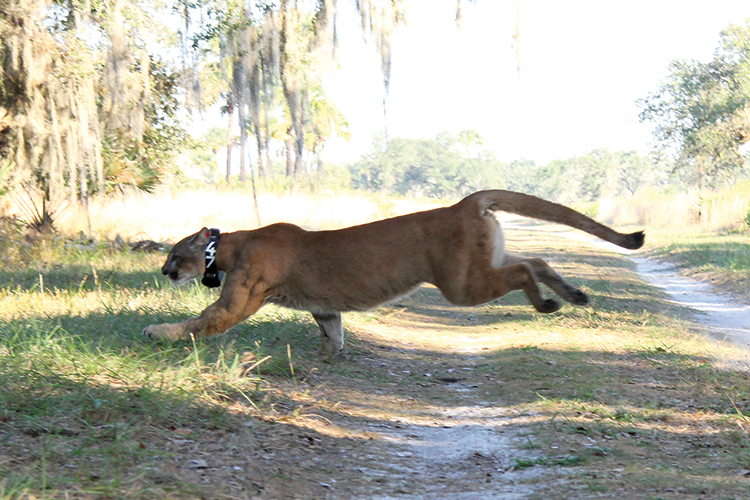
Photo courtesy of the Florida Fish and Wildlife Conservation Commission
Big cats prowling Alabama? Not likely!
Every year, hunters and other outdoorsmen report seeing large cats in Alabama and other eastern states where none should exist.
Cougars, also called mountain lions or pumas, once ranged from northern Alaska to the tip of South America. The eastern subspecies roamed over most of North America east of the Mississippi River, but allegedly went extinct in the 1940s. About 100 Florida panthers, another cougar subspecies, still live in extreme southwestern Florida.
“Cougars are the only big cat species to historically call Alabama home,” says Thomas E. Harms, the large carnivore biologist for the Alabama Department of Conservation and Natural Resources. “Their historic range covered the whole state and they were common here.”
Fearsome predators, cougars can weigh more than 200 pounds and easily bring down deer, elk, cattle and other large animals, even humans! Since the earliest colonization of North America, people tried to exterminate cougars and other predatory threats to themselves and their livestock. As the human population grew, forests became croplands and pastures. By the early 20th century, few large cats remained east of the Mississippi River.
“The last confirmed cougar killed in Alabama was in St. Clair County in 1948,” Harms says. “Since the 1960s, nothing has been confirmed.”
In 1961, a cougar track was confirmed in Clarke County. In the late 1960s, another track was found in the same general area. Also in the late 1960s, an Alabama conservation enforcement officer found a cougar den with cubs in northern Baldwin County.
The Endangered Species Act placed big cats in most states under federal protection. For decades, known cat populations in protected areas began increasing. Expanding populations may force young cougars to spread out to find their own home ranges. A solitary and incredibly elusive adult cougar might call several hundred square miles home.
“Cougar populations are on the rebound,” Harms says. “As a biologist, I cannot say that a cougar doesn’t exist in Alabama, but we have nothing to confirm that they do reside in or are passing through the state. There have been confirmed sightings in Louisiana, Arkansas and Tennessee.”
In November 2008, a man shot a healthy 140-pound fully clawed male cougar on the Georgia side of West Point Lake, which straddles the Georgia-Alabama line near Roanoke, Ala. DNA evidence confirmed it as a Florida panther, which possibly wandered up from Florida.
Each year, people report seeing not just big cats, but black panthers. “Panthers” never existed as a distinct species, but people often call cougars, South American jaguars and African leopards “panthers.” No documented cougar in history ever had black fur, although bobcats sometimes occur in black or melanistic phases. The scientific name for cougar, Puma concolor, means “cat of one color.” Leopards and jaguars can occur in black phases.
“Genetically, it is not possible for cougars to have a black phase,” Harms says. “Most pictures of black cats circulating around are pictures of the black phase of a jaguar or leopard or a regular black house cat, but I will not discourage anybody from sending me a picture for verification.”
People reporting “black panthers” usually see something else such as Labrador retrievers, raccoons, small bears, big house cats, coyotes, foxes, feral pigs or dark-colored bobcats. People could possibly see a genuine cougar in silhouette, dark shadows or caked in mud. Many big cat reports occur at night or during low-light conditions when distinguishing colors becomes extremely difficult. Sometimes, people might see an actual tan cougar, but remember it as black because that’s what they wanted to see.
One afternoon, my son and I drove through a wildlife management area. Canals paralleled the road. We spotted a large dark animal crossing the road about 75 yards ahead of us. Both of us immediately thought “cat,” because of how it moved, its size and long tail. I stepped on the gas. Seconds later, we reached the spot where the “black cat” disappeared and saw a very large, but normal, brown otter swimming in the canal. We didn’t expect to see an aquatic otter crossing the dry road in mid-afternoon. In the distance and because of the way light filtered through the trees, the silhouetted otter looked black.
Another long-tailed cat, a jaguarundi, resembles a small cougar. About the size of a large house cat, a jaguarondi at 25 yards could look like a lion 100 yards away. These South American felines range as far north as southern Texas, but have been released in Florida.
“There have been reports of jaguarundis in Alabama, but we have not been able to confirm them,” Harms says. “Jaguarundis can be hard to differentiate from a regular house cat. They are similar in size and color.”
Anyone shooting a cougar in Alabama could face severe penalties. People who think they have spotted a cougar, tracks or other evidence should contact Harms or the nearest district wildlife office.
“If we believe that is it a credible sighting, we would investigate further. Try not to disturb any evidence, if possible.”
Contact Harms at 251-626-5474 in the wildlife office in Spanish Fort.




